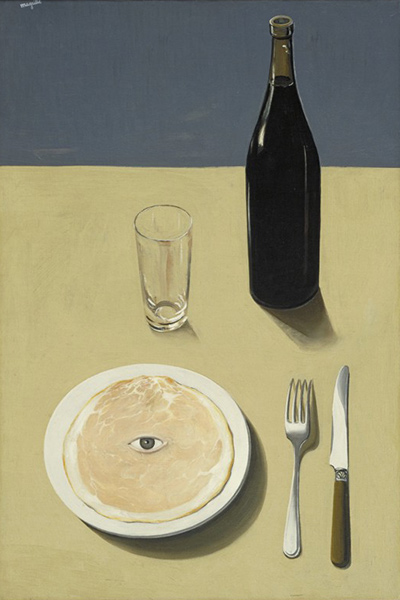The Portrait is an oil painting, measuring 73.3 x 50.2 cm, completed by the highly original Belgian surrealist, Rene Magritte, in 1935. It now hangs in New York's Museum of Modern Art and shares several characteristics of other works painted by him.
Rene Magritte and his version of Surrealism
Although Magritte was considered one of the great surrealists he did not conform with others in the group. This was largely because he was opposed to Sigmund Freud's writings on psychoanalysis which greatly influenced the First Surrealist Manifesto written in 1924. He did agree with the other surrealists' desire to reveal hidden reality but was hostile to the idea that this could be achieved by any kind of dream interpretation. This was due, in part, to a dislike of self-expression and self-projection popular with many artists at the time. Despite Magritte's dislike of dream interpretation, however, he was interested in the pre-conscious state before waking. Although some critics described Magritte's work as 'visual thinking' he disliked explanations of his work and particularly the idea of symbols.
"Seeing is what matters" is what Magritte said, knowing that his viewers would be almost immediately surprised into seeing familiar objects in new ways. Magritte's unique vision was achieved by his use of a visually realistic portrayal of objects rather than the distorted shapes preferred by painters such as Dali and Ernst. The surreal nature of Magritte's work was achieved by the construction of strange contexts and the unexpected juxtaposition of ordinary artefacts such as shelves, shoes, windows, doors, chairs, tables as well as ordinary living things such as trees and people.
The Painting: The Portrait
The canvas was exhibited in several 1930s exhibitions and was later acquired by Kay Sage Tanguy who donated it to New York's Museum of Modern Art in 1956. A larger 3-D version was exhibited in a 1945 Brussels surrealist display. The exact meaning of 'The Portrait' is disputed but the brilliance of it lies in the fact that a person is represented not by their face, as is conventional, but by a ritual small meal eaten by that person. Within the painting is a realistic looking bottle of red wine and glass, a plate of ham and a knife and fork. The startling thing about the picture is that there is a small eye looking at the viewer from the middle of the plate. This tiny eye is challenging the potential eater and is completely different to the huge eye in Magritte's painting 'The False Mirror' which does not actively look but merely reflects.
The eye in 'The Portrait' demands that the ham is taken seriously and is respected. According to Chaim Koppelman in The Surreal is Everyday: The Art of Rene Magritte this picture demonstrates the comtempt Magritte thought people had for real objects with their wish to possess and then dispose of them. This wish, according to Koppelman, makes reality easier to manage. He sees the eye as a symbol of conscience though Magritte famously disliked symbols. Koppelman quotes Eli Siegel who claims that in digesting food people are "using the world" in their way. Siegel thought that Magritte's "objects will object" when showed contempt. The artefacts in 'The Portrait' appear to be powerless and ready to be used as part of the meal but the eye gives power to the ham and, perhaps, to the other objects. The ham demands to be taken seriously in a similar way, as Koppelman says, to the apple in Magritte's painting 'The Listening Room'.
A modern interpretation, with our interest in vegetarianism, might see the eye as emphasising the pig's consciousness before it was made into ham. It is worth remembering, though, that Magritte did not like interpretation of his paintings. Perhaps it is more useful to have a further look at the techniques Magritte used. One technigue used in this picture, according to the New York Museum of Modern Art, is the use of a perspective that tilts towards the picture's plane inviting the viewer to join in what initially appears to be an appealing meal. This makes the shock of the challenging actively seeing eye even more powerful. As in many of Magritte's other pictures he is mocking the viewer and attempting, by an almost instant affect, to change the way the viewer sees everyday objects including those in this pictue of a small meal so familiar it has become a ritual.




